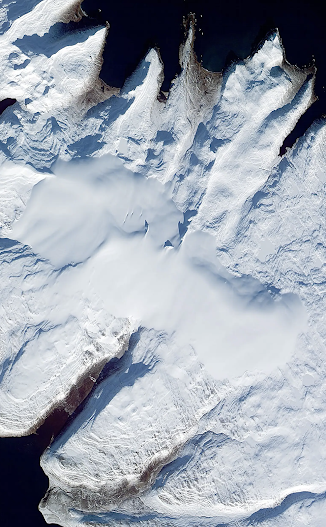
Mid-Devensian climate and landscape in England: new data from Finningley, South Yorkshire
Philip I. Buckland et al, Royal Society Open Science 6 (7),
Published:10 July 2019
Patton, H., Hubbard, A., Glasser, N. F., Bradwell, T. & Golledge, N. R. 2013 (July): The last Welsh Ice Cap: Part 1 – Modelling its evolution, sensitivity and associated climate. Boreas, Vol. 42, pp. 471–490.
The last Welsh Ice Cap: Part 1 – Modelling its evolution, sensitivity and associated climate.
But at what point does streaming ice from far afield start to affect an area like West Wales, where there may be lowlands, upstanding hill masses and plateaux which might support local ice caps? It's clear that this happens very late in the day, towards the back end of a full glacial cycle. The glacierization build-up phase (with extensive snow and ice cover on the landscape) may last for 70,000 years or more, interrupted by short-lived cooling and warming phases or by changes in precipitation and other types of "climatic forcing". But eventually, when the whole land surface has become deeply buried by locally-generated ice, maybe 500m or more in thickness, the big brute from the north begins to dominate -- in this case with the arrival of the Irish Sea Ice Stream - as cold-based ice is replaced by ice that is capable of sliding on its bed. Streaming ice then begins to do serious damage, eroding bedrock, picking up erratics and incorporating pre-existing periglacial and other deposits, and modifying a previously protected landscape in a multitude of different ways. The direction of ice flow is now determined not by the details of local topography but by the surface gradient of the ice stream; in the case of Pembrokeshire ice movement seems to have swung through an arc of maybe 60 degrees, but with a dominant flow from NW towards SE. It appears that the Welsh ice cap did not greatly affect Pembrokeshire, but ice from the Welsh uplands may well have filled Cardigan Bay, creating a constriction that affected Irish Sea ice flow directions. From the BRITICE-CHRONO modelling, Irish Sea ice affects the area for maybe 3,000 years.
https://www.science.org/content/article/watch-ice-sheet-melt-and-great-britain-and-ireland-emerge#.Y2DUPaCmHNI.twitter
Then, after maybe less than 1,000 years of "peak glaciation" the ice sheet starts to collapse, and the ice stream power is dramatically reduced. Forward flow is stopped, and catastrophic ice wastage sets in -- so that a landscape deeply inundated beneath glacier ice is gradually revealed, with an intermittent cover of glacial and fluvioglacial deposits which are remobilised and redistributed as the last remnants of buried ice melt away.
On a glacial cycle timeline this is all very asymmetrical, with (1) a long period of "increasing glacierisation" with minimal landscape effects followed by (2) a period of intense activity involving streaming ice and then (3) by a short period of catastrophic ice wastage and sediment redistribution. That's the simplest situation imaginable. Of course, in reality it is always more complex. Climatic oscillations occur on a variety of different scales, and long-term cooling is sometimes interrupted by intermittent warmer phases, just as long-term warming is interrupted by "cold snaps" such as the Younger Dryas phase of c 12,000 years ago and the Little Ice Age that set in during the Middle Ages. Changes in oceanic and atmospheric circulation can also have the effect of changing wind direction and strength, and changing patterns of precipitation. These are all things that are built into the increasingly sophisticated modelling of ice sheet growth and decay by the BRITICE-CHRONO group and others.
So just as the idea of a spectacular ice front marching across the landscape is an image that has no basis in reality, the idea of a later ice front retreating across a landscape during deglaciation is equally misleading. Ice stops moving forward -- it does not RETREAT. It simply wastes away where it lies, mostly from the top down. So just as the local ice caps of Aubrac in France and Glamajökull in Iceland melted away completely, leaving but a few traces of their former existence, the same thing is happening at the moment to Drangajökull, leaving very few traces up on the high plateau where ice movement was minimal, but complex associations of glacial and fluvioglacial deposits and landforms in the valleys affected by streaming ice.
And we should be careful about using the term "ice limits" as well. I have to admit to using the term far too frequently myself, as a shorthand expression which is easily understood. On Quaternary maps we see "ice limits" portrayed all too often as straight lines, even across mountainous terrain -- but in reality ice edges are generally "fingered" or crenellated in sympathy with the landscape, and beyond an ice sheet edge there are generally scores if not hundreds of smaller icefields, ice caps and snowfields -- again in sympathy with the lie of the land and the patterns of snowfall. So the real ice edge is not just crenellated but also fragmented.........
https://brian-mountainman.blogspot.com/2022/10/the-inexorable-ice-front-fact-or-fiction.html
https://brian-mountainman.blogspot.com/2022/10/the-aubrac-ice-sheet.html
https://brian-mountainman.blogspot.com/2022/10/lessons-from-aubrac.html
https://brian-mountainman.blogspot.com/2012/08/the-ice-sheet-ice-cap-snowfield.html
https://brian-mountainman.blogspot.com/2009/12/lessons-from-jameson-land.html
https://brian-mountainman.blogspot.com/2011/01/last-glaciation-protective-ice-cover-in.html
So how does all this relate to the evidence on the ground in West Wales and elsewhere? Watch this space.......
One of the biggest problems with all of this is the claim by Rolfe et al that Lundy Island was affected by glacier ice during the Early Devensian:
https://brian-mountainman.blogspot.com/2015/03/a-lundy-island-spat.htmlRolfe, C.J., Hughes, P.D., Fenton, C.R., Schnabel, C., Xu, S., Brown, A.G., 2012. Paired 10Be and 26Al exposure ages from Lundy: new evidence for the extent and timing of Devensian glaciation in the southern British Isles. Quaternary Science Reviews 43(2012): 61-73.










No comments:
Post a Comment